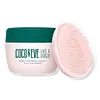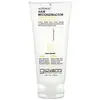What's inside
What's inside
 Key Ingredients
Key Ingredients

 Benefits
Benefits

 Concerns
Concerns

 Ingredients Side-by-side
Ingredients Side-by-side

Water
Skin ConditioningCetearyl Alcohol
EmollientCocos Nucifera Fruit Extract
EmollientDimethicone
EmollientBehentrimonium Chloride
PreservativeParfum
MaskingGlycerin
HumectantCetyl Alcohol
EmollientSodium Benzoate
MaskingFicus Carica Fruit Extract
HumectantArgania Spinosa Kernel Oil
EmollientShea Butter Ethyl Esters
EmollientCaryocar Brasiliense Fruit Oil
Skin ConditioningRicinus Communis Seed Oil
MaskingHydrolyzed Linseed Extract
Skin ConditioningLeuconostoc/Radish Root Ferment Filtrate
AntimicrobialPhenoxyethanol
PreservativeCetrimonium Chloride
AntimicrobialPotassium Sorbate
PreservativeEthylhexylglycerin
Skin ConditioningSelaginella Lepidophylla Extract
EmollientSaccharomyces/Silicon Ferment
Skin ConditioningSaccharomyces/Iron Ferment
Skin ConditioningSaccharomyces/Magnesium Ferment
Saccharomyces/Copper Ferment
Skin ConditioningSaccharomyces/Zinc Ferment
Skin ConditioningTocopherol
AntioxidantLactobacillus Ferment
Skin ConditioningBenzyl Alcohol
PerfumingBenzyl Salicylate
PerfumingCoumarin
PerfumingLimonene
PerfumingLinalool
PerfumingWater, Cetearyl Alcohol, Cocos Nucifera Fruit Extract, Dimethicone, Behentrimonium Chloride, Parfum, Glycerin, Cetyl Alcohol, Sodium Benzoate, Ficus Carica Fruit Extract, Argania Spinosa Kernel Oil, Shea Butter Ethyl Esters, Caryocar Brasiliense Fruit Oil, Ricinus Communis Seed Oil, Hydrolyzed Linseed Extract, Leuconostoc/Radish Root Ferment Filtrate, Phenoxyethanol, Cetrimonium Chloride, Potassium Sorbate, Ethylhexylglycerin, Selaginella Lepidophylla Extract, Saccharomyces/Silicon Ferment, Saccharomyces/Iron Ferment, Saccharomyces/Magnesium Ferment, Saccharomyces/Copper Ferment, Saccharomyces/Zinc Ferment, Tocopherol, Lactobacillus Ferment, Benzyl Alcohol, Benzyl Salicylate, Coumarin, Limonene, Linalool
Water
Skin ConditioningCetyl Alcohol
EmollientStearalkonium Chloride
PreservativeTocopherol
AntioxidantCitric Acid
BufferingPhenoxyethanol
PreservativeParfum
MaskingHelianthus Annuus Seed Oil
EmollientGlycine Soja Seed Extract
Skin ConditioningBetula Alba Bud Extract
Skin ConditioningMalva Sylvestris Extract
AstringentAchillea Millefolium Extract
CleansingChamomilla Recutita Flower Extract
MaskingEquisetum Arvense Extract
AstringentLavandula Angustifolia Extract
Skin ConditioningRosmarinus Officinalis Leaf Extract
AntimicrobialSalvia Sclarea Extract
AntiseborrhoeicThymus Vulgaris Extract
PerfumingTussilago Farfara Flower Extract
AstringentUrtica Dioica Extract
AstringentWater, Cetyl Alcohol, Stearalkonium Chloride, Tocopherol, Citric Acid, Phenoxyethanol, Parfum, Helianthus Annuus Seed Oil, Glycine Soja Seed Extract, Betula Alba Bud Extract, Malva Sylvestris Extract, Achillea Millefolium Extract, Chamomilla Recutita Flower Extract, Equisetum Arvense Extract, Lavandula Angustifolia Extract, Rosmarinus Officinalis Leaf Extract, Salvia Sclarea Extract, Thymus Vulgaris Extract, Tussilago Farfara Flower Extract, Urtica Dioica Extract
Ingredients Explained
These ingredients are found in both products.
Ingredients higher up in an ingredient list are typically present in a larger amount.
Cetyl Alcohol is a fatty alcohol. Fatty Alcohols are most often used as an emollient or to thicken a product.
Its main roles are:
Though it has "alcohol" in the name, it is not related to denatured alcohol or ethyl alcohol.
The FDA allows products labeled "alcohol-free" to have fatty alcohols.
Learn more about Cetyl AlcoholParfum is a catch-all term for an ingredient or more that is used to give a scent to products.
Also called "fragrance", this ingredient can be a blend of hundreds of chemicals or plant oils. This means every product with "fragrance" or "parfum" in the ingredients list is a different mixture.
For instance, Habanolide is a proprietary trade name for a specific aroma chemical. When used as a fragrance ingredient in cosmetics, most aroma chemicals fall under the broad labeling category of “FRAGRANCE” or “PARFUM” according to EU and US regulations.
The term 'parfum' or 'fragrance' is not regulated in many countries. In many cases, it is up to the brand to define this term.
For instance, many brands choose to label themselves as "fragrance-free" because they are not using synthetic fragrances. However, their products may still contain ingredients such as essential oils that are considered a fragrance by INCI standards.
One example is Calendula flower extract. Calendula is an essential oil that still imparts a scent or 'fragrance'.
Depending on the blend, the ingredients in the mixture can cause allergies and sensitivities on the skin. Some ingredients that are known EU allergens include linalool and citronellol.
Parfum can also be used to mask or cover an unpleasant scent.
The bottom line is: not all fragrances/parfum/ingredients are created equally. If you are worried about fragrances, we recommend taking a closer look at an ingredient. And of course, we always recommend speaking with a professional.
Learn more about ParfumPhenoxyethanol is a preservative that has germicide, antimicrobial, and aromatic properties. Studies show that phenoxyethanol can prevent microbial growth. By itself, it has a scent that is similar to that of a rose.
It's often used in formulations along with Caprylyl Glycol to preserve the shelf life of products.
Tocopherol (also known as Vitamin E) is a common antioxidant used to help protect the skin from free-radicals and strengthen the skin barrier. It's also fat soluble - this means our skin is great at absorbing it.
Vitamin E also helps keep your natural skin lipids healthy. Your lipid skin barrier naturally consists of lipids, ceramides, and fatty acids. Vitamin E offers extra protection for your skin’s lipid barrier, keeping your skin healthy and nourished.
Another benefit is a bit of UV protection. Vitamin E helps reduce the damage caused by UVB rays. (It should not replace your sunscreen). Combining it with Vitamin C can decrease sunburned cells and hyperpigmentation after UV exposure.
You might have noticed Vitamin E + C often paired together. This is because it is great at stabilizing Vitamin C. Using the two together helps increase the effectiveness of both ingredients.
There are often claims that Vitamin E can reduce/prevent scarring, but these claims haven't been confirmed by scientific research.
Learn more about TocopherolWater. It's the most common cosmetic ingredient of all. You'll usually see it at the top of ingredient lists, meaning that it makes up the largest part of the product.
So why is it so popular? Water most often acts as a solvent - this means that it helps dissolve other ingredients into the formulation.
You'll also recognize water as that liquid we all need to stay alive. If you see this, drink a glass of water. Stay hydrated!
Learn more about Water